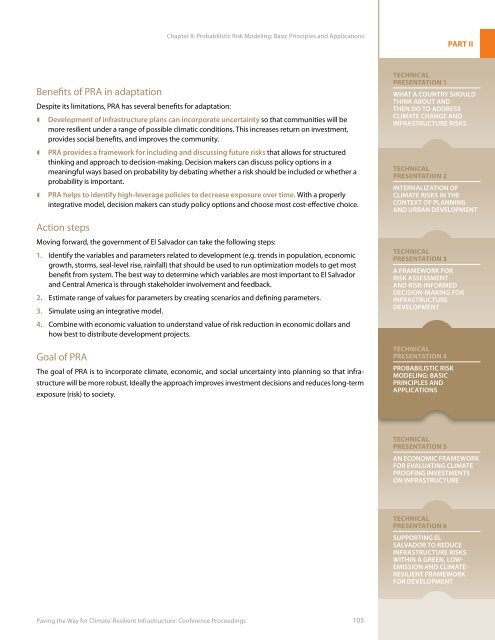Paving the Way for Climate-Resilient Infrastructure - UN CC:Learn
Paving the Way for Climate-Resilient Infrastructure - UN CC:Learn
Paving the Way for Climate-Resilient Infrastructure - UN CC:Learn
Create successful ePaper yourself
Turn your PDF publications into a flip-book with our unique Google optimized e-Paper software.
Chapter 8: Probabilistic Risk Modeling: Basic Principles and ApplicationsPART IIBenefits of PRA in adaptationDespite its limitations, PRA has several benefits <strong>for</strong> adaptation:Development of infrastructure plans can incorporate uncertainty so that communities will bemore resilient under a range of possible climatic conditions. This increases return on investment,provides social benefits, and improves <strong>the</strong> community.PRA provides a framework <strong>for</strong> including and discussing future risks that allows <strong>for</strong> structuredthinking and approach to decision-making. Decision makers can discuss policy options in ameaningful ways based on probability by debating whe<strong>the</strong>r a risk should be included or whe<strong>the</strong>r aprobability is important.PRA helps to identify high-leverage policies to decrease exposure over time. With a properlyintegrative model, decision makers can study policy options and choose most cost-effective choice.TechnicalPresentation 1What a Country ShouldThink About andThen Do to Address<strong>Climate</strong> Change and<strong>Infrastructure</strong> RisksTechnicalPresentation 2Internalization of<strong>Climate</strong> Risks in <strong>the</strong>Context of Planningand Urban DevelopmentAction stepsMoving <strong>for</strong>ward, <strong>the</strong> government of El Salvador can take <strong>the</strong> following steps:1. Identify <strong>the</strong> variables and parameters related to development (e.g. trends in population, economicgrowth, storms, seal-level rise, rainfall) that should be used to run optimization models to get mostbenefit from system. The best way to determine which variables are most important to El Salvadorand Central America is through stakeholder involvement and feedback.2. Estimate range of values <strong>for</strong> parameters by creating scenarios and defining parameters.3. Simulate using an integrative model.4. Combine with economic valuation to understand value of risk reduction in economic dollars andhow best to distribute development projects.Goal of PRAThe goal of PRA is to incorporate climate, economic, and social uncertainty into planning so that infrastructurewill be more robust. Ideally <strong>the</strong> approach improves investment decisions and reduces long-termexposure (risk) to society.TechnicalPresentation 3A Framework <strong>for</strong>Risk Assessmentand Risk-In<strong>for</strong>medDecision-Making <strong>for</strong><strong>Infrastructure</strong>DevelopmentTechnicalPresentation 4Probabilistic RiskModeling: BasicPrinciples andApplicationsTechnicalPresentation 5An Economic Framework<strong>for</strong> Evaluating <strong>Climate</strong>Proofing Investmentson <strong>Infrastructure</strong>TechnicalPresentation 6Supporting ElSalvador to Reduce<strong>Infrastructure</strong> Riskswithin a Green, Low-Emission and <strong>Climate</strong>-<strong>Resilient</strong> Framework<strong>for</strong> Development<strong>Paving</strong> <strong>the</strong> <strong>Way</strong> <strong>for</strong> <strong>Climate</strong>-<strong>Resilient</strong> <strong>Infrastructure</strong>: Conference Proceedings 105
















